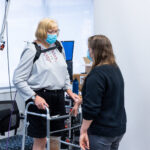Two years ago, the world saw Jan Scheuermann, a woman with quadriplegia, feed herself chocolate using a robot arm she controlled with her thoughts. Last night, a University of Pittsburgh research team published their latest findings in the Journal of Neural Engineering: Scheuermann was able to shape the robot hand into several positions to pick up a variety of objects, achieving what it is believed to be the highest degree of control of a prosthetic arm to date.
Scheuermann concluded her participation in the project in October. Here is an excerpt of a letter she wrote to the team and her family and friends before she had surgery to remove the brain-computer interface implants:
“I fully expect to miss all of it, but that’s not a regret of having done [it]. I hope to keep busy enough writing and speaking about this experience to fill my time. It’s the people I will miss. I so appreciate the dedication of everyone who has worked on this study. They have dedicated their lives to studying brain surgery, human rehabilitation needs, brain-computer interfaces, computer engineering, biomedical engineering, grant writing, robotic limb building, and all the other myriad professions that have all merged and contributed to this one study.
“Long after my name is forgotten, and the names of all the scientists who worked on this project are forgotten, our work will stand and will benefit future generations of paralyzed people and amputees.”
Photo courtesy of the Journal of Neural Engineering/IOP Publishing.









